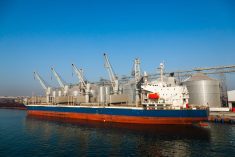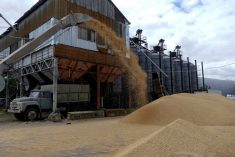Despite a dramatically lower Prairie grain handle in the last crop year, the Western Grains Research Foundation can expect a $5.7 million gift card from Canada’s big two railways by the end of next month.
The Canadian Transportation Agency, which sets the maximum revenue entitlements (MREs) each crop year for Prairie grain handled by Canadian National Railway (CN) and Canadian Pacific Railway (CP), on Thursday ruled both railways overshot their maximums for the 2021-22 crop year.
The CTA’s determination found CN’s regulated grain revenue came in $3,068,088 above its MRE of $589,140,501 for the crop year, while CP’s came in $2,363,775 above its MRE of $513,144,863.
Read Also

Huge crops in South America says analyst
Although there’s a debate over the size of the South American soybean crop, there’s little doubt that it will be an enormous one, said consultant Michael Cordonnier of Soybean and Corn Advisor in Hinsdale, Ill.
As per grain handling regulations, those overages must be forfeited in the next 30 days to the Western Grains Research Foundation (WGRF), along with penalties of five per cent ($153,404 for CN, $118,189 for CP) — for a combined payout of $5,703,456.
The CTA’s figures show CN and CP moved a combined 28.4 million tonnes of western grain in 2021-22 crop year — a “notable drop” of 46 per cent from their combined record 52.3 million-tonne handle in 2020-21, “due mainly to the drought conditions experienced in Western Canada during the (2021-22) growing season.”
The CTA’s calculations showed the average lengths of haul for CN and CP in 2021-22 to be 977 miles and 909 miles respectively, for a combined weighted average length of haul of 946 miles, down from 966 in 2020-21.
In 2020-21, by comparison, the CTA had found CN overshot its MRE by almost $2.4 million, while CP came in about $20.25 million below its MRE. Prior to that, both railways overshot their MREs in five of six crop years, except for 2018-19 when grain revenue came in below both railways’ MREs.
The MREs, commonly described as revenue caps, are calculated using a formula factoring in each railway’s annual grain handle and average length of haul along with the volume-related composite price index (VRCPI), an inflation index reflecting the railways’ costs for labour, fuel, materials and capital purchases.
The 2021-22 crop year is the fourth in which CN and CP have separate VRCPIs, following amendments to the Canada Transportation Act in 2018.
CN’s 2021-22 VRCPI was set at 1.4572, up from 1.4441 in 2020-21, while CP’s was set at 1.4826, down from 1.5055.
Those figures were reached after both railways applied for, and received, adjustments to their previously-announced 2021-22 VRCPIs. CP sought an adjustment based on its purchases of 1,400 new hopper cars and CN, for purchasing and leasing 1,075 additional hopper cars — transactions which weren’t accounted for when the VRCPIs were first set.
The WGRF’s research fund, the agreed-upon beneficiary from MRE overages since 2000, is a Saskatoon-based, producer-directed fund that backs crop research to “enhance the profitability and sustainability” of western Canadian grain farmers. — Glacier FarmMedia Network
















